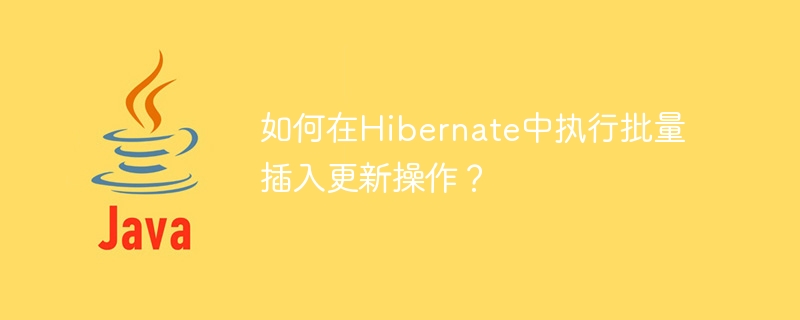Maison >Java >javaDidacticiel >Comment effectuer des opérations de mise à jour d'insertion groupée dans Hibernate ?
Comment effectuer des opérations de mise à jour d'insertion groupée dans Hibernate ?
- WBOYWBOYWBOYWBOYWBOYWBOYWBOYWBOYWBOYWBOYWBOYWBOYWBavant
- 2023-08-27 23:17:061580parcourir

在本文中,我们将看到如何在Hibernate中执行批量插入/更新。
每当我们执行一条sql语句时,我们都是通过对数据库进行网络调用来完成的。现在,如果我们必须向数据库表中插入 10 个条目,那么我们必须进行 10 次网络调用。相反,我们可以通过使用批处理来优化网络调用。批处理允许我们在单个网络调用中执行一组 SQL 语句。
为了理解和实施这一点,让我们定义我们的实体−
@Entity
public class Parent {
@Id
@GeneratedValue(strategy = GenerationType.AUTO)
private long id;
private String name;
// Getters
//Setters
}
为了在Hibernate中启用批处理,我们需要向我们的应用程序添加一个属性
properties文件:spring.jpa.properties.hibernate.jdbc.batch_size=3
现在,我们需要执行EntityManager的persist函数将数据插入数据库
示例
@Autowired
private EntityManager entityManager;
@Test
Public void InsertInBatch(){
for (int i = 0; i < 6; i++) {
Parent parent = Parent[i];
entityManager.persist(parent);
}
}
输出
"batch":true, "querySize":1, "batchSize":3, "query":["insert into parent (name, id) values (?, ?)"], "params":[["P1","1"],["P2","2"],["P3","3"]] "batch":true, "querySize":1, "batchSize":3, "query":["insert into parent (name, id) values (?, ?)"], "params":[["P4","4"],["P5","5"],["P6","6"]]
从控制台我们可以看到,插入父表的操作是在批量大小为3的情况下进行的。
在持久化实体时,可能会发生OutOfMemoryException,因为Hibernate将实体存储在持久化上下文中。因此,出于优化目的,我们可以在每批之后使用实体管理器的flush()和clear()。
批量更新意味着在一次网络调用中更新大量数据。
对于批量更新,流程是相同的。我们需要在应用程序属性文件中添加以下两个语句,然后执行更新过程。
spring.jpa.properties.hibernate.order_updates=true spring.jpa.properties.hibernate.batch_versioned_data=true
示例
更新数据的代码−
@Autowired
private EntityManager entityManager;
@Test
public void UpdateInBatch() {
TypedQuery<Parent> query = entityManager.createQuery("SELECT p from Parent p", Parent.class);
List<Parent> Parents = query.getResultList();
int i=1;
for (Parent parent : Parents) {
String s="Parent"+Integer.toString(i);
i++;
parent.setName(s);
}
}
Hibernate 现在会将这些语句绑定在一个批处理中并执行它们。
输出
"batch":true, "querySize":1, "batchSize":3, "query":["update parent set name=? where id=?"], "params":[["Parent1","1"],[" Parent2","2"],[" Parent3","3"]] "batch":true, "querySize":1, "batchSize":3, "query":["update parent set name=? where id=?"], "params":[["Parent4","4"],["Parent5","5"],["Parent6","6"]]
从控制台可以看到,父表中的数据更新是在批量大小为3的情况下进行的。
Ce qui précède est le contenu détaillé de. pour plus d'informations, suivez d'autres articles connexes sur le site Web de PHP en chinois!

